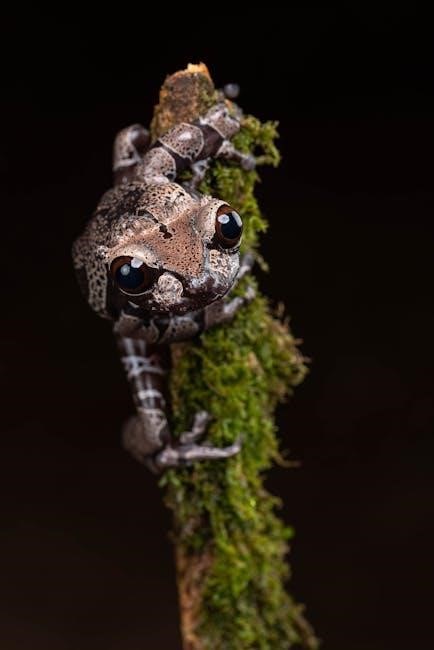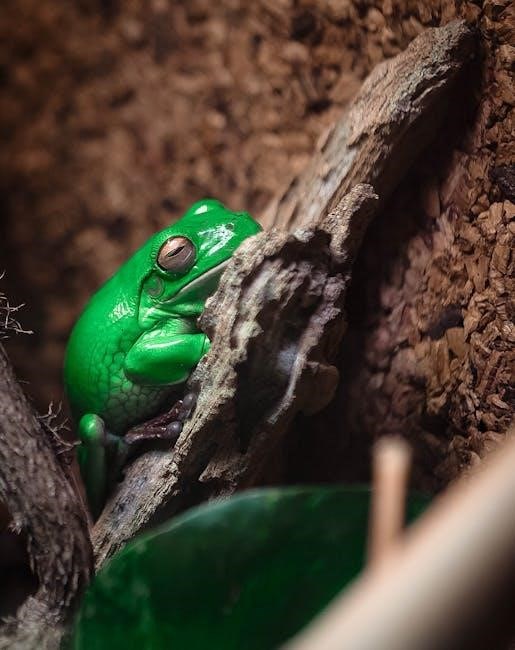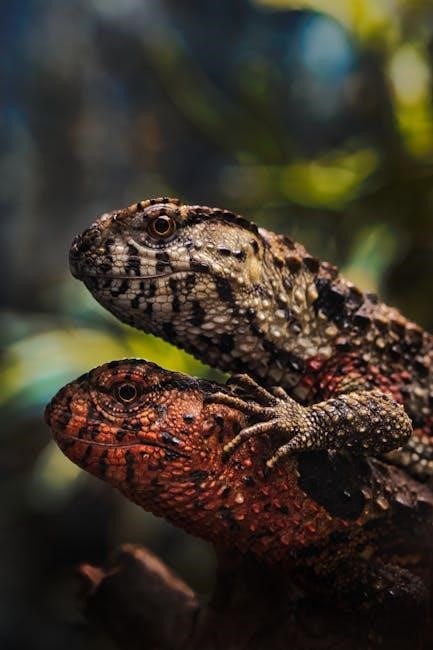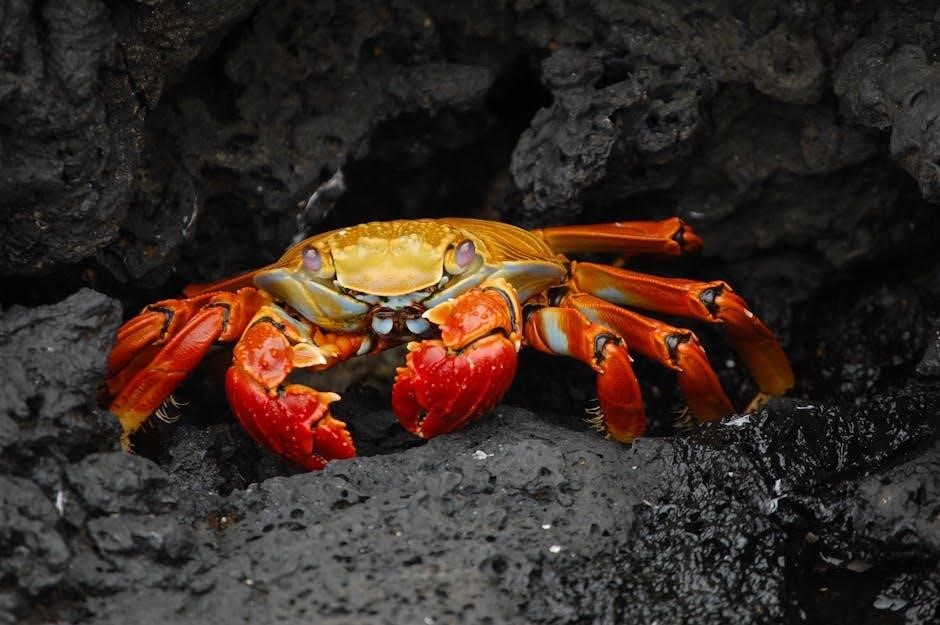Conservation biology is a multidisciplinary field focused on understanding and addressing threats to biodiversity. It emphasizes the protection of species, ecosystems, and genetic diversity to ensure ecological stability and sustainability. This discipline integrates biology, ecology, genetics, and social sciences to develop practical solutions for species conservation and ecosystem restoration. The primary goal is to prevent extinction and promote the recovery of threatened populations while addressing human impacts on the environment. Conservation biology also highlights the importance of biodiversity in maintaining healthy ecosystems and providing essential services to humanity.
1.1 Definition and Scope
Conservation biology is defined as the scientific study of biodiversity loss and the development of strategies to preserve species and ecosystems. Its scope encompasses the protection of genetic, species, and ecosystem diversity, addressing threats like habitat destruction, invasive species, and climate change. This field integrates biology, ecology, and social sciences to understand human impacts and promote sustainable practices. Conservation biology aims to maintain ecological integrity and ensure the survival of species by addressing both immediate and long-term environmental challenges.
1.2 Importance of Biodiversity
Biodiversity is the foundation of healthy ecosystems, providing essential services like pollination, water purification, and soil fertility. It ensures ecological resilience, allowing systems to recover from disturbances. Genetic diversity within species enhances adaptability to environmental changes, while species diversity maintains ecosystem balance. Biodiversity also offers direct benefits, such as food, medicine, and cultural value. Its loss disrupts ecosystem functions, leading to reduced productivity and increased vulnerability to climate change. Preserving biodiversity is crucial for human well-being and the sustainable functioning of Earth’s ecosystems.
1.3 Key Objectives of Conservation Biology
The primary objectives of conservation biology include preventing species extinction, restoring degraded ecosystems, and promoting sustainable use of natural resources. It aims to identify and mitigate threats to biodiversity, such as habitat loss and invasive species. Conservation biology also seeks to develop effective management strategies for threatened populations and ecosystems, ensuring their long-term survival. Additionally, it emphasizes the importance of public education and policy development to integrate conservation practices into societal frameworks, fostering a balance between human needs and environmental protection.
Threats to Biodiversity
Key threats to biodiversity include habitat destruction, invasive species, overexploitation, and climate change. These factors disrupt ecosystems, leading to population declines and species extinction, undermining ecological balance.
2.1 Habitat Loss and Fragmentation
Habitat loss and fragmentation are primary threats to biodiversity, driven by deforestation, urbanization, and agriculture. These processes reduce available land for species, isolate populations, and disrupt ecosystems. Fragmented habitats limit species’ ability to migrate, find mates, and access resources, leading to population decline. The loss of critical habitats, such as rainforests and wetlands, exacerbates extinction risks. Conservation efforts must address these issues to preserve biodiversity and maintain ecological balance.
2.2 Invasive Species and Their Impact
Invasive species are non-native organisms that disrupt local ecosystems, threatening biodiversity. They outcompete native species for resources, alter habitats, and spread diseases. Human activities like trade and travel often facilitate their introduction. Invasive species can cause significant ecological and economic damage, such as reducing crop yields and degrading natural habitats. Examples include the emerald ash borer and zebra mussels in North America. Managing invasive species requires early detection, eradication efforts, and public awareness to mitigate their harmful effects on ecosystems and native biodiversity.
2.3 Overexploitation of Resources
Overexploitation of resources refers to the excessive use of natural resources, leading to their depletion and harm to ecosystems. Human activities such as overfishing, deforestation, and unsustainable hunting threaten species survival. This exploitation disrupts ecological balances, reducing biodiversity and impairing ecosystem services. For instance, overfishing depletes fish populations, affecting marine food chains, while logging leads to habitat loss. Addressing overexploitation requires sustainable practices, regulation, and global cooperation to ensure resource use does not exceed ecological limits, preserving biodiversity for future generations.

Conservation Strategies
Conservation strategies include in-situ and ex-situ methods, restoration ecology, and genetic diversity management to protect and restore ecosystems and species effectively for long-term sustainability.
3.1 In-Situ Conservation Methods
In-situ conservation focuses on protecting species within their natural habitats through habitat restoration, legal protections, and management of human activities. It aims to maintain biodiversity by preserving ecosystems and ecological processes. Techniques include establishing protected areas, controlling invasive species, and implementing sustainable land-use practices. In-situ methods are often more effective for maintaining genetic diversity and ecological interactions compared to ex-situ approaches. They also address broader environmental issues, ensuring the long-term survival of species in their natural environments while promoting coexistence with human communities.
3.2 Ex-Situ Conservation Techniques
Ex-situ conservation involves protecting species outside their natural habitats, often in controlled environments like zoos, botanical gardens, or seed banks. These methods are particularly useful for species threatened by habitat loss or extinction. Techniques include captive breeding programs, artificial propagation, and cryopreservation of genetic material. Ex-situ conservation helps maintain genetic diversity, supports reintroduction efforts, and raises public awareness about endangered species. While it complements in-situ efforts, it is often a last resort when natural habitats are severely degraded or no longer viable for species survival.
3.3 Restoration Ecology and Its Role
Restoration ecology focuses on repairing degraded or damaged ecosystems to restore their natural functions and biodiversity. It involves reintroducing native species, removing invasive ones, and rehabilitating habitats. This approach enhances ecosystem resilience, improves water and air quality, and supports pollination and nutrient cycling. Restoration also mitigates climate change by sequestering carbon and protecting endangered species. While challenges like limited funding and climate variability exist, successful projects demonstrate the potential to recover ecosystems, ensuring their stability and benefits for future generations. Restoration ecology is a critical tool in broader conservation strategies.
Genetic Diversity in Conservation
Genetic diversity is crucial for species survival, enabling adaptation to environmental changes. It enhances resilience, supports evolutionary processes, and ensures long-term ecosystem stability, aiding conservation efforts effectively.
4.1 The Role of Genetic Diversity in Species Survival
Genetic diversity is essential for species survival, enabling populations to adapt to changing environments and resist diseases. It provides the raw material for evolution, ensuring resilience against environmental shifts and predators. Higher genetic diversity fosters healthier populations, reducing extinction risks. Without it, species face limited adaptability, making them vulnerable to threats like climate change and invasive species. Conservation efforts often prioritize genetic diversity to maintain robust populations capable of enduring ecological challenges and supporting biodiversity. This underscores its critical role in long-term species persistence and ecosystem health.
4.2 Conservation Genetics: Tools and Applications
Conservation genetics employs advanced tools like DNA sequencing and genotyping to study genetic diversity and population structure. These techniques help identify conservation priorities, such as genetically unique individuals or populations. Applications include developing breeding programs for endangered species and monitoring genetic health over time. Additionally, genetic data informs reintroduction strategies and helps mitigate inbreeding depression. Conservation genetics also aids in understanding migration patterns and adapting species to climate change, making it a vital component of modern biodiversity preservation efforts. Its insights are crucial for designing effective conservation plans.

Education and Training in Conservation Biology
Education and training are critical for building expertise in conservation biology. Programs for students and professionals focus on species identification, restoration techniques, and data analysis to address biodiversity challenges effectively.

5.1 Training Programs for Students and Professionals

Training programs in conservation biology are essential for equipping students and professionals with practical skills. These programs often include coursework, fieldwork, and lab sessions, focusing on biodiversity assessment, species identification, and habitat restoration. Many universities offer specialized degrees and certifications, emphasizing hands-on experience. Workshops and seminars provide updates on emerging technologies and research methodologies. Such programs foster collaboration between academia and conservation organizations, preparing individuals to address real-world challenges effectively. They also emphasize the integration of theory with practical application to ensure successful conservation outcomes.
5.2 The Importance of Public Awareness
Public awareness is crucial for the success of conservation efforts. Educating communities about biodiversity threats fosters understanding and engagement. Awareness campaigns highlight the consequences of habitat loss, invasive species, and overexploitation, encouraging individuals to adopt sustainable practices. Public support is vital for policy implementation and funding conservation projects. By fostering a connection between people and nature, awareness campaigns can inspire behavioral change and community involvement. Ultimately, an informed society is better equipped to contribute to biodiversity preservation and support conservation initiatives effectively.
Case Studies in Conservation Biology
Case studies provide practical insights into conservation efforts, highlighting successes and challenges. They illustrate the effectiveness of strategies and offer lessons for future biodiversity management.

6.1 Successful Conservation Projects
Successful conservation projects highlight effective strategies to protect and restore biodiversity. For instance, the reintroduction of wolves in Yellowstone improved ecosystem balance, enhancing biodiversity and stabilizing prey populations. Similarly, the recovery of bald eagles in North America demonstrates the impact of habitat protection and chemical regulation. These projects emphasize the importance of interdisciplinary approaches, genetic diversity, and community involvement. They also illustrate how restoration ecology can reverse environmental damage, ensuring long-term species survival and ecosystem health. Such successes provide valuable lessons for addressing global conservation challenges.
6.2 Lessons Learned from Failed Conservation Efforts
Failed conservation efforts often highlight critical mistakes, such as inadequate consideration of genetic diversity or insufficient community involvement. For example, the introduction of invasive species, like the disastrous 1960s examples, disrupted local ecosystems irreversibly. Overreliance on single strategies without addressing broader environmental issues, such as climate change, has also led to failures. These cases underscore the importance of holistic approaches and adaptive management. They also emphasize the need for long-term monitoring and the integration of ecological, social, and economic factors to avoid repeating past mistakes in conservation biology.

Future Directions in Conservation Biology
Future directions in conservation biology include leveraging emerging technologies, addressing climate change impacts, and integrating restoration ecology to protect biodiversity and ecosystems sustainably.
7.1 Emerging Trends and Technologies
Emerging trends in conservation biology include the use of advanced technologies like artificial intelligence, machine learning, and genomic tools. These technologies aid in monitoring biodiversity, predicting species extinction risks, and developing targeted conservation strategies. Drones and satellite imagery are increasingly used for habitat mapping and tracking wildlife populations. Additionally, innovations in restoration ecology, such as ecosystem engineering and climate-smart conservation, are gaining prominence. These tools enhance the efficiency and scalability of conservation efforts, enabling scientists to address complex challenges more effectively and sustainably.
7.2 Addressing Climate Change in Conservation
Climate change poses significant threats to biodiversity, including rising temperatures, altered ecosystems, and extreme weather events. Conservation efforts must integrate climate resilience strategies, such as assisted migration and climate-smart conservation planning. Restoration ecology plays a critical role in enhancing ecosystem adaptability. Additionally, reducing greenhouse gas emissions is essential to mitigate climate impacts on biodiversity. Conservation biologists are increasingly focusing on adaptive management practices to help species and ecosystems cope with climate-driven changes, ensuring long-term survival and ecological balance in a rapidly changing world.